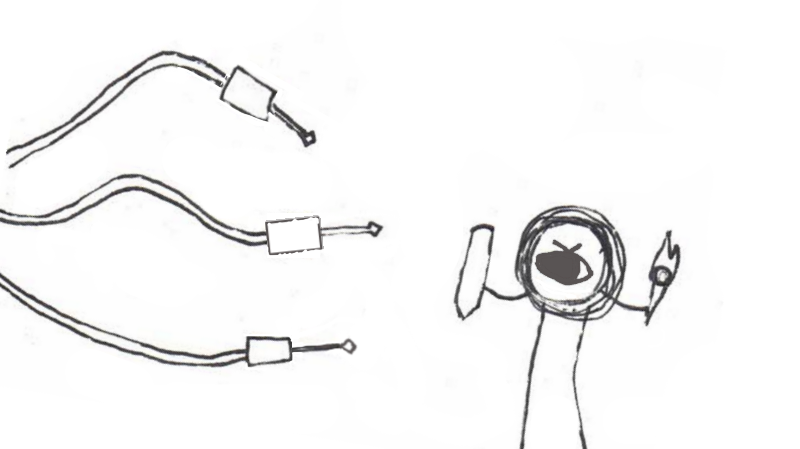
If you had a CRT monitor and had other systems to hook up to it, you might remember the three-headed plug-ins that they used to take. The backs of those giant monitors looked like a Star Trek dashboard, with all sorts of ports for all sorts of cords. Parallel ports, TV direct-line ports, dial up, serial ports, all kinds of ports. Truly, information could come from anywhere, as long as there was a plug to connect two things to each other. Nowadays, the HDMI has become the first choice of data-transmitting plug, but the three-headed plug hasn’t completely disappeared.
What Was It?
The jack I’m remembering is also known as an RCA connector. There were two popular types: composite, and component. There were usually three heads, all part of the same cable, and the output side was color coded to match an input side on the television.
To get input from your device to the TV, you’d have to match up the plugs, which each carried a different signal to the plugs on the other side. This tech uses analog signals to send the information to the TV, instead of digital, like HDMI’s use.
The three plugs on a composite type RCA consisted of ‘composite’ video, left-side audio, and right-side audio. Component video had plug-ins for just the red/blue/green components of the image, instead of including audio in the jack hydra. ‘So what?’ you might say. Nowadays, that’s just more steps to get to the same result, a clear video with stereo audio. Back then, separating the signals was the only way the tiny computer in the television could handle it. It wasn’t about the cable’s capacity, it was about the TV – and computers were weak when composite RCAs were introduced. If all three output cables were instead fused into one, the final quality of the broadcast would be noticeably worse on screen.
Composite video, in this way, was a breakthrough! Splitting it up meant that the TV processor didn’t have to make some huge leap to clear the gap between black-and-white and color. The downside was the split: the video had a maximum possible quality, and it wasn’t very far away from where they were already. Composite was the quick solution, but the video had to be compressed to traverse the cable, and the analog signal could come out fuzzy if the screen was too big, or if something producing radio waves (like a faulty microwave, or a radio) was too close by. Component signals TV was a similar breakthrough, and suddenly TVs were high-definition – separating out the colors instead of putting them all in one meant that more information was reaching the screen, resulting in a better picture. People were already used to that three-port system, so a straightforward upgrade was welcomed pretty quickly. Audio was separate, but whatever, the picture was crystal clear!
RCAs were also great even later because of the freedom they gave the host TV – you could have multiple rows of RCA inputs on the backs of the particularly large TVs, so houses with a VCR and a game console wouldn’t have to unplug one to put in the other. Nowadays, TVs that do still have RCA connections have maybe one or two sets for component video, and HDMI is expected to fill in the rest.
Why Did Manufacturers Switch?
RCA connectors sound great on paper, and they can give a lot of freedom. However, composite video RCAs buzz if they’re not connected right, they’re easily tangled, they look messy, and they’re all around slightly worse quality-wise than HDMI, depending on screen size. Particularly the video: HDMI can deliver a much better-quality image than composite RCAs could because it was digital, not analog. Not much could compete, although the UK had an equivalent called a SCART connector that behaved a lot like component RCA did. And then HDMI came along and blew RCA and SCART out of the water! An RCA cable could never handle 4K TV. Component video, which only focused on video, hung in where composite RCA failed because the quality was better. Component can produce images up to 1080p because instead of one compressed visual signal, it has three! Component RCA is still on the backs of TVs even to this day.
Besides quality, they looked messy. HDMIs might still be cords, but they’re all more or less uniform in size, so they look nicer behind a TV. RCA cables could be any number of sizes because they needed shielding, so the cable could be thicker or thinner depending on the manufacturer. HDMIs can carry both audio and video, and TVs are smarter, so there’s no need to divvy up the information before the computer receives it. Even if all else was equal, manufacturers might have still switched to HDMI, to lighten the load for the customer.
Still, a lot of old consoles and DVD players with component options only are still kicking around, so component RCA ports are going to hang around a little longer.
Sources:
https://www.pcmag.com/encyclopedia/term/composite-video
Hyperlink for Readability: MultiCom Inc.


